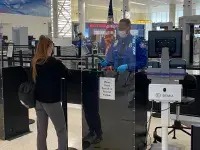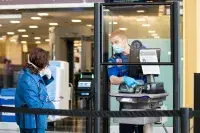 Passengers can expect to see various styles of plastic shields at the travel document checking podium at airports. This one is at Ronald Reagan Washington National Airport. (TSA photo)
Passengers can expect to see various styles of plastic shields at the travel document checking podium at airports. This one is at Ronald Reagan Washington National Airport. (TSA photo)
WASHINGTON – As the summer travel season hits full stride and with the July 4th holiday just days away, the Transportation Security Administration (TSA) has announced the agency’s new “Stay Healthy. Stay Secure.” campaign, which focuses on airport checkpoint modifications to help contain the spread of COVID-19, comply with CDC guidelines and support healthy and secure summer travel to help prevent the spread of COVID-19.
Throughout the month of June, TSA saw an increase in the number of individuals coming through airport checkpoints and is monitoring the growth closely for staffing and security purposes.
“During the pandemic our TSA officers have remained vigilant in their security mission, continuing to focus on security measures while maintaining social distancing and wearing masks,” said Scott T. Johnson, TSA’s Federal Security Director for Ronald Reagan Washington National Airport and Washington Dulles International Airport. “Passengers will see TSA officers changing gloves after each pat-down and using a fresh swab when checking for explosive material.”
“Passengers should be wearing facial protection and practicing social distancing in the checkpoint line,” said Andrea R. Mishoe, TSA’s Federal Security Director for
Baltimore/Washington International-Thurgood Marshall Airport. “Please note, however, passengers may be required to adjust their masks during the screening process to verify ID or if their mask triggers an alarm.”
Procedural changes that travelers should expect are outlined below.
- Passengers should keep possession of their boarding passes. Instead of handing their boarding pass to a TSA officer at the travel document podium, travelers should place their boarding pass (paper or electronic) on the boarding pass reader themselves. After scanning, travelers should hold their boarding pass toward the TSA officer to allow the officer to visually inspect it. This change reduces the TSA officer’s need to touch a passenger’s boarding pass, thus reducing potential for cross-contamination.
- Travelers should separate food for X-ray screening. Passengers should place their carry-on food items into a bin. Why? Because food items often trigger an alarm during the screening process; separating the food from the carry-on bag lessens the likelihood that a TSA officer will need to open the carry-on bag and remove the food for a closer inspection. It is recommended to pack the food in a clear plastic bag and place the clear bag of food into the bin. This requirement reduces the TSA officer’s need to touch a person’s carry-on bag and container of food and reduces potential for cross-contamination. TSA PreCheck™ members do not need to remove items from their bags.
- Passengers may bring one liquid hand sanitizer container, up to 12 ounces per passenger, in carry-on bags. Passengers are required to remove the large hand sanitizer from their carry-on bag and place it in a bin for additional screening. Passengers should expect that the screening of a large container of hand sanitizer is likely to take some extra time. Other liquids, gels and aerosols in a carry-on bag continue to be limited to a maximum of 3.4 ounces per item and all of those items must fit into a one clear quart-size bag.
- If a carry-on bag is found to contain a prohibited item, passengers may be directed to return to the divestiture table outside of security with their carry-on bags to remove the item and dispose of the item. The passenger may also be directed back outside of security to remove, items that should have originally been divested (such as laptops, liquids, gels, and aerosols, and large electronics) and resubmit their property for X-ray screening. By resolving alarms in this manner, TSA officers will not need to touch the contents inside a carry-on bag as frequently, reducing the potential for cross-contamination.
Passengers also will notice protective plastic shields at the travel document checking locations at airports.
Beyond TSA checkpoint area changes, many airlines and airports are providing specific COVID-19 and summer travel season related guidance. Travelers should check with their airline prior to their trip to determine if the airline has made any changes to procedures.
As passenger volumes continue to rise, TSA recommends that travelers arrive to the airport early since new procedures, such as social distancing, may add time to the pre-flight experience. This practice ensures adequate time for checking bags, completing security screening and getting to the departure gate on time.
For more information about TSA’s response to COVID-19 and other adjustments TSA has made at security screening checkpoints, please visit tsa.gov.


